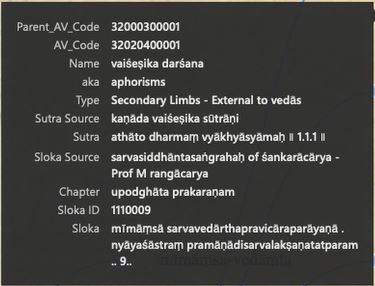This is a unique ‘rare-book-review’ project turned out as a humble attempt to showcase sanātana vidyā paraṃpara (ancient Indian Knowledge Systems (IKS) using data visualization tool.
The book that was used as source here is ‘Sarva Siddhanta Sangraha‘ by Adi Shankaracharya. Shri Shankara did pūrvapakṣa on six dominant darśanā-s (schools of philosophy) that were prevalent at his time (5th Century BCE).
For starters, pūrvapakṣa is “an ancient dharmic technique where a debater must first authentically understand in the opponent’s perspective, test the merits of that point of view and only then engage in debate using his own position. Purva-paksha encourages individuals to become truly knowledgeable about all perspectives, to approach the other side with respect and to forego the desire to simply win the contest. Purva-paksha also demands that all sides be willing to embrace the shifts in thinking, disruptive and controversial as they may be, that emerge from such a dialectical process.” (Courtesy: Rajiv Malhotra, author Being Different).
If you want to directly jump into the visual, please expand by clicking <open full-screen mode> ![]() symbol on the bottom right portion of below interactive report for better visual experience. You can come back to this web page again by clicking <close full-screen mode>
symbol on the bottom right portion of below interactive report for better visual experience. You can come back to this web page again by clicking <close full-screen mode> ![]() on the visual. It is recommended to view below report only on computer or laptop or other bigger screens. In the alternative, if you want to know more about the visual, please scroll down and review page-wise topics before getting into the visual.
on the visual. It is recommended to view below report only on computer or laptop or other bigger screens. In the alternative, if you want to know more about the visual, please scroll down and review page-wise topics before getting into the visual.
Please note that it is essential to visit the report and navigate through the report pages to appreciate the model built. Introduction to this project, FAQs etc. are already part of 13 page report embedded below. You may want to scroll down this page to get know more about page-wise details of topics on the visual before exploring below visual. However, the contents shown under Topics here is no substitute to the report embedded below.
Below interactive report is NOT built for mobile.
Page-wise Topics on the Visual
- About this Project*
- Anubaṃdha Catuṣṭaya*
- Aṣṭādaśa Vidya (Drill-down View)
- Sanātana Vidya (Galaxy view)
- Darśanas (Schools of Philosophy) – A Brief Summary*
- Darśana (Hierarchy View)
- Pūrvapakṣa (Arguments Proposed) (Drill-down View)*
- Pūrvapakṣa (Debate Highlights)*
- Vedāṃta (Drill-down)*
- Vedāṃta Vṛkṣa (Reconciliation)*
- References / Sources
- ṣaḍdarśana sūtras (aphorisms of six schools)
- FAQs
P.S. Pages marked on the visual with (*) are in English (IAST) and Telugu only. Others also support Devanagari also.
1. About this Project
Sanātana vidyā paraṃpara (timeless knowledge traditions) – Darśanā (schools of philosophy) is an innovative attempt to introduce sanātana knowledge systems and ancient knowledge traditions.
1.1 Foreword
India is the cradle of all education. Indian darśanas are the oldest among world darśanas. Vedās are the source of all these.
Every creature in the world desires ‘Let all sorrows be gone! Let happiness come!’ It is but natural to want that way. Various darśanas came into existence to provide means to relieve the sorrows of humankind and bring eternal happiness.
It is natural for a person of intelligence to get doubts at the primordial, metaphysical, and spiritual levels which can be overcome only by gaining the knowledge of darśanas.
Among the various darśanas that appeared in India from time immemorial, some were Vedic, i.e. they accept authority of Vedic scriptures. Some darśanas remain silent on the nature of God though they accept the authority of scriptures. Some other darśanas are non-vaidika. viz., they deny Vedic authority. There are the ones which are set out to establish the ultimate truth with the help of intellect and logic. Some of these accept orthodox sanātana doctrines (such as cycle of karmā-janmā). Some disagree. Therefore, it was not possible to reach a consensus on the nature of truth. Thus, these darśanas, at times, appear to take some mutually exclusive stand on critical aspects of truth, each taking their own path.
There are many books in Indian darśanas and Shankara’s book ‘Sarva Siddhanta Sangraha‘ has a special place. Hence, this book is current topic. The primary source is Shri Garimella Somayajulu Sharma’s translation as part of ‘Sankara Grandha Ratnavali‘ published by Sadhana Grandha Mandali, Tenali. For English version, ‘sarva siddhaanta samgraha of sankaraachaarya‘ by Professor M Rangacharya published in 2006 by Eastern Book Linkers based on the original work by the author in 1908. This author reportedly used multiple original sources including manuscripts / tāḻapatra‘s. English meanings to ślokas are sourced from this work.
1.2 Warning
No matter how intelligent or devoted one is, one cannot study Vedānta śāstra by himself / herself and gain experience. ātma vidyā is tough and is only possible through a competent guru and is knowable through traditional methods of teaching.
1.3 Inspiration
The inspiration behind this endeavor is to introduce sanātana darśanas in an easy-to-understand manner and to inspire the present ‘internet’ generation to explore the depths of sanātana education systems. This (mis)adventure is through the introduction of a rare, authentic and standard text.
2. Anubaṃdha Catuṣṭaya
One of the best practices associated with sanātana vidyā tradition is that study of śāstra starts with anubaṃdha catuṣṭaya (four-fold connection). This provides a litmus test for understanding whom the śāstra is meant for (adhikāri), what the (topic) deals with (viṣaya), what benefit(s) one gets by pursuing it (prayojana) and how all these are related / connected (saṃbandha). First few lines of the śāstra are designed to answer all these four-fold connections. This helps the seeker to determine whether or not to pursue the śāstra study even before he starts the study.
In this traditional way, the second page of the visual attempted to presenting what this project is about to help visitors of this site to determine whether this subject is for them. The second page on the interactive visual above helps you to explore and find out the anubaṃdha catuṣṭaya for this project. Just hover mouse on each color of the Donut/Pie Chart on report to see full details on the tool-tip.
2.1.1 adhikāri
2.1.1.1 Who is this meant for?
If you are an enthusiast or student or teacher or researcher in the field of Indic Research (Indian Philosophy, Religion(s) and History), this project is just for you.
2.1.1.2 Basic skiils required?
Basic computer navigation skills are all that is required to use this project.
2.1.1.3 Languages?
Ability to read Telugu or Devanagari script is sufficient to explore this tool.
2.1.1.4 Can’t read both
If unable to read both Devanagari or Telugu, IAST (International Alphabet of Sanskrit Transliteration) script is there to help.
2.1.1.5 Can read Sanskrit
Knowledge of Sanskrit is a bonus.
2.1.1.6 For starters..
No problem. This is still useful. More skills are required only if you want to do more using this idea. Like building something similar or for expanding the scope of this project like adding additional resources to the framework.
2.1.1.7 No reading habit?
This project will help you get a big picture without needing to go through many works on the subject. However, if you want to explore further, you should not only be willing to read but also find a right guru.
2.1.2 viṣaya
2.1.2.1 What is the purpose?
The purpose of this project is to provide a bird’s eye view of sanātana knowledge systems.
2.1.2.2 What are the topics?
These visualizations attempt to deal with the topic in two parts:
(1) mapping the sources of sanātana knowledge systems and
(2) compare various darśana’s
2.1.2.3 What primary sources?
The primary source used for this project is sarvasiddhāntasaṅgrahaḥ ascribed to śrīmacchaṅkarācārya which was widely referenced to by almost all the authors on the works referenced herein.
2.1.2.4 Why ādi śaṃkarā?
sarva darśana saṃgraha of ādi sankarācārya (509 BCE – 477 BCE) is considered the most authentic and comprehensive review and analysis of major schools of Bharatiya philosophy both theistic and atheistic. His work faithfully presents the conclusions of all the schools, in lucid language. In his own unique style, sankarā assumes role of the follower of each school while offering arguments in favour of each school. He not only debated and resolved the flaws in various darśanā’s but also reconciled the best arguments from each school and brought them into the bigger umbrella viz., advaita vedānta aligning at the same time with the teachings of upaniśad’s. All major works after sankarācārya only endorsed śankarādvaita darśanā as the ultimate teaching intended by the vedās and hailed his as a great work. His teachings are eternally relevant in spite of additional fragmentation of the philosophies in the sub-continent since śankarā. Hence, ādi sankarācārya as the source.
2.1.2.5 What other sources?
Other sources where used, are flagged appropriately and can be interactively excluded from the visuals. Inclusion of other resources is to provide big-picture which is the primary objective of this project.
2.1.2.6 Is this scalable?
The framework is scalable. For example, it is easy to port the contents to other Indian languages using standard transliteration software or add additional resources (also see attributions page).
2.1.3 prayojana
2.1.3.1 Teaching aid
Serves as a good teaching aid or toolkit.
2.1.3.2 Creates interest
Serves to show how the subject matter is worthy of further exploration due to the eternal relevance of the subject matter.
2.1.3.3 Useful as crash course
Serves as a crash course to the young lot who, in spite of low attention span, have a lot of curiosity, willingness to learn and possess necessary skills to explore visuals.
2.1.3.4 Mother Tongue
Shows how knowledge of mother tongue is sufficient to unpack sanatāna knowledge systems. though saṃskṛt skill and a competent guru, are both a must for a deeper dive into the subject matter.
2.1.3.5 Disrupts teaching tools
Triggers the imagination of a tech-savvy generation to take this humble idea to disrupt the way the subject is taught today at all levels by introducing innovative tools.
2.1.3.6 Essential learning
The visuals help appreciate how each knowledge system stemmed out of the same source(s) and how each have evolved (or evolving) to appear distinct from one another.
2.1.3.7 Compels further exploration
We hope this compels the true seeker some guiding light to find and explore more resources and possibly an appropriate subject matter and right guru.
2.1.3.8 Mind mapping made easy
In view of the complexity of the subject matter, book readers, podcast listners, YouTube watchers find it is always a challenge to relate the topics because the traditional teaching methods are long lost. This efforts is to make the mind-mapping easy.
2.1.4 saṃbandha
2.1.4.1 How is this relevant now?
This project highlights the fundamental questions relevant to all humans irrespective of time and space (location) or ethnicity. It helps to appreciate how our rishis have deep dived into the topic and gifted to humankind an alixir of knowledge ready to be consumed.
2.1.4.2 How this works?
The project attempts to illustrate how sanātana knowledge systems can be de-composed into multiple data points and map them using authentic works.
2.1.4.3 Does this answer all my questions?
No. This is by no means an attempt to provide the underlying knowledge that is referenced here.
2.1.4.4 Is this all I needed?
No. You will need further resources and competent guru / teacher if you want to deep-dive into the subject matter.
2.1.4.5 How is this different?
Though there is a lot of literature available, very of few works / websites provide a big picture, in a way which makes sense to a starter.
The existing / available resources are either too technical OR unreliable due to the interpretations getting lost in multiple layers of translations, leaving the starters uninterested. Hence this effort.
2.1.4.6 One stop reference
Once fully developed, this framework could serve as a one stop-reference point for sanātana knowledge systems.
 2.2 Salutations to gurūs (teachers)
2.2 Salutations to gurūs (teachers)
Before the start of teaching, it is customary to offer salutations to the gurus in the paraṃpara. Right from the īśvara / paramātmā to the present teacher.
sadāśiva samāraṃbhāṃ śaṃkarācārya madhyamāṃ ।
asmadācarya paryāntaṃ vande guru paraṃparāṃ ॥
Meaning: Salutation to the lineage starting with Lord sadāśiva, with ādi śaṃkarā in the middle and continuing up to my immediate teacher.
 2.3 śānti mantrā (pāṭha)
2.3 śānti mantrā (pāṭha)
The teacher and students together chant śānti mantrā before and at the end of each session. Depending on the type of śāstra study one is embarking on, the śānti pāṭha is chosen.
oṃ saha nāvavatu . saha nau bhunaktu . sahavīryaṃ karavāvahai .
tejasvi nāvadhītamastu . mā vidviṣāvahai ..
oṃ śāntiḥ śāntiḥ śāntiḥ ..
Meaning:
Om! May He protect us both together; may He nourish us both together;
May we work conjointly with great energy,
May our study be vigorous and effective;
May we not mutually dispute (or may we not hate any).
Om! Let there be peace in me!
Let there be peace in my environment!
Let there be peace in the forces that act on me!
2.4 Attributions
2.4.1 Primary Source (Sanksrit-Telugu)
For Telugu version, the primary source used was Sankara Grandha Ratnavali published in 2001 by Sadhan Grandha Mandali, Tenali, India – a commentary-cum-translation in Telugu by Shri Garimella Somayajulu Sarma who reviewed most of the available works shown on References page herein. Telugu slokas and translations are sourced from this work.
2.4.2 Secondary Source (Sanskrit-English)
For English version, ‘sarva siddhaanta samgraha of sankaraachaarya’ by Professor M Rangacharya published in 2006 by Eastern Book Linkers based on the original work by the author in 1908. This author reportedly used multiple original sources including manuscripts / tāḻapatra’s. English meanings to slokas are sourced from this work.
2.4.3 Transliteration
For transliteration, courtesy Sanscript tool at https://sanskritdocuments.org/
2.4.4 Validations
For validations, https://vedicheritage.gov.in/ was referenced.
2.4.5 Text condensation
Wherever text condensation was required, like condensation of arguments on the pūrvapakṣaḥ and vedāṃta vṛkṣa pages, https://translate.google.com/ was discretely used.
2.4.6 Icon courtesy
Icon courtesy: https://www.flaticon.com/
2.4.7 Project owners
Vishwanadh Sattiraju https://vishwanadh.com
2.5 Claimers
2.5.1 Errors
I claim full responsibility for all errors, omissions and misrepresentations which one may find herein despite my best efforts. This may be due my misunderstanding or lack of comprehension over the subject matter. There is no intent to offend anyone in the eternal guru paraṃparā. I bow to all the gurus who intended to pass on true knowledge to the humankind. If I have failed them by misquoting them (the gurus), it is unintentional and I am happy to correct myself based on feedback.
2.5.2 Inconsistencies
Inconsistencies are unavoidable for multiple reasons viz., typos, translation / transliteration errors particularly in the pūrvapakṣaḥ page where a lot of liberty is taken to condense the content from sources. In such case, consider Telugu version as more authentic than others as the Project Owners’ primary source is Telugu.
2.6 Disclaimers
2.6.1 Timeline
Every researcher in Indic studies understands that Wikipedia is not a go-to place when it comes to dating of Indian history. Dating of ādi śaṃkara (509 BCE – 477 BCE), without dispute, is one of the pillars of Indian History. Adi śankara’s timeline is one classic example to showcase how distortions in relative chronology cause cascading effect of every important milestone in Indian History. Why use any other source for dating other than than Kamakoti Peetha https://www.kamakoti.org/ which is the live lineage of Adi Shankara himself? In any case, dating is not in scope here. Dating of history is a project in itself.
2.6.2 Copyright
These visuals are for educational and research purpose only. No commercial purpose intended and no copyright violations applicable. Users of these visuals are also encouraged to explore their own resources to validate.
3. Aṣṭādaśa Vidya (Drill-down View)
Vedās are the primary source of knowledge in India. The four vedās are ṛk, yajus, sāma and atharva. The auxiliary limbs (angās of the vedās), the second limbs (upāngās thereof), and the supplementary vedās (upavedā are all helpful to the vedās themselves. They form the sources of knowledge regarding duty (dharma), wealth (artha) desire (kāma) and final deliverance (mokṣa); and are fourteen in number.
The auxiliary limbs of the vedās are the following six, viz.,the science of accent and phonetics (śikṣa) grammar (vyākaraṇa) etymology and interpretation (nirukta) astronomy (jyotiṣa) and ritual code (kalpa) and also prosody (chaṃdoviciti).
The secondary limbs (of the vedās) are the following four viz., mīmāṃsa, nyāyasutra (the science of reasoning), the purāṇa and the smṛti: these are in fact (the indirectly connected) outer limbs of the vedās.
The supplementary vedās are of four kinds: and they are āyurveda (science of medicine), arthaveda (science of wealth and government), dhanurveda (archery and the science of war), and gāndharvaveda (the science of art of music).
Overall, Indian education should be linked to these 18 vidyas.
In the third page of the above interactive report, an attempt has been made to show the contents of these educations as a branch view. Though, broadly only one source was used for and each language as mentioned in the Foreword above, a few other sources were also used for completeness as the spirit of the project is to link the knowledge systems.
Please hover on the blue dot and when the ‘+’ sign appears, click the ‘+’ sign to drill-down until you see white dot which indicates end of the tree / branch. When you hover on the blue-dot or white-dot you will see the tool-tip providing more information as shown in picture below.
As far as possible the Shloka and Sutra in the source (if related to the Sutra) are indicated for validation by tool-tip to the branch-items in this report as shown below.

4. Sanātana Vidya (Galaxy view)
We believe the best part of the visualization project is page 4. Since, everything in Sanātana Vidya has to connect to the 18 principle categories of knowledge, the concepts, terms and the tattvas upto the paramāṇu (atom) are mapped to each school. As the name suggests it happens to be synonymous to a galaxy in the sky and it gets rather unwieldy, filters were provided to view the mappings in different categories. We hope the navigation easy and the instructions on the report page are self-explanatory. This helps mind-mapping easy. The tool-tips should provide guidance for deeper dive based on the śloka or sūtra as the case may be. You are encouraged to use the mouse to expand and contract the screen within the galaxy view. In this page also, though, broadly only one source was used for and each language as mentioned in the Foreword above, a few other sources were also used for completeness as the spirit of the project is to link the knowledge systems.
5. Darśanas (Schools of Philosophy) – A Brief Summary
Darśanas can be loosely translated as ‘schools of philosophy’. Please note that darśana is NOT meant to be synonymous with religion (as the word is currently understood). However, the darśanas rejected by sanātana traditions or those fragmented or break-away schools are today followed like religion. In simplistic terms, a darśana is that vision of vedic philosophy by a particular draṣṭa (riṣi or seer) who codified this view into sūtras which are then developed into a ‘school of philosophy’ and then passed on to the lineage of gurus.
The darśanas were founded by various riṣis sometime between post-vedic period (from upaniśadic age to sūtrā period, also called smṛti period). The teachings of six darśanas are available to date in the form of sūtrās which refers to one of the three principle styles found in Saṃskrit literature. This is a very terse form of writing with no embellishment. The sentence consists of few words and no narrative, explanation or dilation. They are meant for easy memorization by students and depended upon the commentary given by learned scholars, hence require extensive commentaries.
There may be many translations in Telugu and other Indian languages on various darśanas , especially Shankara’s ‘Sarva Siddhanta Sangraha’.
The sadhaka world owes so much to such learned and talented writers and translators.
The pūrvapakṣa of various darśanas shown by śrīmacchaṃkarācārya in this book, the reconciliation of Vedānta darśana is the proof and to be reckoned as a guiding light.
Among the various darśanas that appeared in India from time immemorial, some were Vedic, i.e. they accept authority of Vedic scriptures. Some darśanas remain silent on the nature of God though they accept the authority of scriptures. Some other darśanas are non-vaidika. viz., they deny Vedic authority. There are the ones which are set out to establish the ultimate truth with the help of intellect and logic. Some of these accept orthodox sanātana doctrines (such as the doctrine of karma). Some disagree. Therefore, it was not possible to reach a consensus on the nature of truth. Thus, these darshans, at times, appear to take some mutually exclusive stand on critical aspects of truth, each taking their own path.
Unfortunately, no standard icons are in vogue to represent the darśanas. Some icons may be more self-explanatory than others. For example, Baudha, Jaina and Yoga darśanas are obvious whereas the others are not. For carvāka, the icon represents the one used by some athiest groups. For vaiśeṣika, the icon represents the ‘atom’ as the concept of paramāṇu was proposed by kaṇāda maharṣi. sāṃkhya icon represents the prakṛti and puruṣa which is the core concept of maharṣi kapila. mīmāṃsa investigates into the vedic knowledge hence, the icon represents magnifying glass. kṛṣṇa‘s teachings highlight the Bharata darśana, hence the conch and peackock feather. Nyaya teaching highlights the concept of logic, conversation and debate. Lastly, the vedānta darśana icon is meant to represent the concept of brahman (oneness) Icon courtesy: https://www.flaticon.com/
5.1 Nāstika Darśana‘s (atheistic schools)
Brihaspati propunded cārvāka darśana; ārhata darśana was created by Jaina; Buddhist darśana was initiated by Buddha. All three practiced in different ways according to their own way of affirmation. Buddhist view, Lokayata (Carvaka) view, Arhata (Jain) view are atheistic views and do not accept Vedic authority. These three darśanas proposed the theories not rooted in Vedas. Therefore, these theories were rejected by sanātanis.
 5.1.1 cārvāka (lokāyata) darśana
5.1.1 cārvāka (lokāyata) darśana
Cārvāka (Lokāyata) Darśana was propounded by Brihaspati. The followers of Cārvāka school are materialists.
 5.1.2 ārhata (jaina) darśana
5.1.2 ārhata (jaina) darśana
ārhata (jaina) darśana was created by Jina Maharṣi. Those who practice Jaina śāstra accept perception, inference and the Jain scriptures as the proof of truth. They believe that their spiritual leader Jina deva is omniscient, omnipotent and universal Lord who can give his followers, the fruits to the mantrās of the jain scriptures.
 5.1.3 bauddha darśana
5.1.3 bauddha darśana
Though Buddha Bhagavān1 is the sole creator of baudha darśana, his four followers have divided into four different sects viz., Mādhyamikās, Yogācārās, Sautrāṃtikās Vaibhāṣikās. While the Mādhyamikās believe that the ether is the ultimate reality, the other three agree that intellect (buddhi) exists in reality. Only Sautrāṃtikās Vaibhāṣikās see all the external world as reality.
1It is said in the Srimad Bhagavatam that Lord Vishnu incarnates as Buddha in the start of Kaliyuga with the intention of seducing the haters of theists.
tataḥ kalau sampravṛtte sammohāya suradviṣām ।
buddho nāmnājanasutaḥ kīkaṭeṣu bhaviṣyati ॥ (1.3.24)
5.1.3.1 mādhyamika (bauddha) darśana
5.1.3.2 yogācāra (bauddha) darśana
5.1.3.3 sautrāṃtika (bauddha) darśana
5.1.3.4 vaibhāṣika (bauddha) darśana
5.2 āstika Darśana‘s (theistic schools)
Kanāda Maharśi founded vaiseṣika darśana; Akṣapāda Maharṣi founded nyāya darśana; Kapila Maharṣi founded sāṃkhya darśana; Pataṃjali Maharṣi founded yoga darśana; Jaimini Maharṣi founded mīmāṃsa darśana; Bādarāyaṇa (Vyāsa) Maharṣi founded vedāṃta darśana. All of them have accepted the authority of the Vedas. Hence, these are the six theistic schools accepted by sanātanis.
 5.2.1 vaiśeṣika darśana
5.2.1 vaiśeṣika darśana
Kanāda Maharṣi is the seer of vaiśeṣika darśana. Vaiśeṣikas say the knowledge of six broad categories of substances will result in mokṣa. From īśvara to all the living beings and everything else in this world is manifestation of these six categories.
 5.2.2 nyāya darśana
5.2.2 nyāya darśana
Akśapāda (Gotama) Maharṣi is the author of nyāya darśana. nyāya śāstra deals with the properties of 16 defined substances. Logic and the method of argumentation originated from nyāya śāstra. nyāya śāstra is an empirical theory of truth-seeking on authenticity based on criteria of truth. What the thorny hedge is for the protection of the growth of the crops raised from the seeds sown in the fields, the hedge consisting of logical reasoning is for the safe-guarding of the truths expounded in the vedās. Everyone should learn tarka śāstra to safeguard vedas.
 5.2.3 sāṃkhya (nirīśvara sāṃkhya) darśana
5.2.3 sāṃkhya (nirīśvara sāṃkhya) darśana
Sāṃkhya darśana has two parts. One is the nirīśvara sāṃkhya, which does not propose the existence of God. Kapila Maharṣi2 propounded the nirīśvara sāṃhya. His theory is that mukti can be attained only through jñāna (knowledge).
2It is said in Srimad Bhagavatam that sage Kapila is an incarnation of Sri Mahavishnu.
pañcamaḥ kapilo nāma siddheśaḥ kālaviplutam ।
provācāsuraye sāṅkhyaṃ tattvagrāmavinirṇayam ॥ (1-3-10)
 5.2.4 yoga (sa-īśvara sāṃkhya) darśana
5.2.4 yoga (sa-īśvara sāṃkhya) darśana
Patanjali Maharṣi preached sa-īśvara sāṃkhya (yoga darśana). The followers of yoga school accept the existence of God. Patanjali proposed 25 tattvas (principles) including prakṛti and puruṣa. He says by understanding these 25 tattvas one will attain yoga siddhi (accomplishment). Through yoga the defects are destroyed. Patanjali‘s theory is that ultimately, yoga leads to mokṣa.
 5.2.5 mīmāṃsa darśana
5.2.5 mīmāṃsa darśana
Both mīmāṃsa and vedāṃta darśanas are theistic schools which uphold vedic authority.
5.2.5.1 pūrva mīmāṃsa (karma kāṃḍa)
Among all the caturdaśa (14) vidyas, mīmāṃsa is the greatest. mīmāṃsa thoroughly investigates the meaning of all the vedic verses. pūrva mīmāṃsa is twelve (12) chapters long and explains about karma kāṃḍa (ritualistic practices). In the uttara mīmāṃsa, the first four chapters of the devatā kāṃḍaṃ are produced by saṃkarṣaṇa. Invocation of devatās (devatopāsana) chanted by vedic mantras is proposed here.
5.2.5.1.1 prabhākara darśana
Guru Prabhākara, a disciple of Sri Kumārila Bhattācharya, interpreted Sabara Bhāshya with a slight difference. This is called Prabhākara mata.
5.2.5.1.2 bhaṭṭācārya darśana
Sri Kumārila Bhattācharya’s interpretation of Sabara Bhāshya on mīmāṃsa śāstra was partially modified by Prabhākara.
5.2.5.2 uttara mīmāṃsa
uttara mīmāṃsa is a science of eight chapters. According to proposed subject, there are two types namely 1) devatā kāṃḍa and 2) jñāna kāṃḍa. Both these branches are based on the vyāsa sūtras.
 5.2.5.2.1 devatā kāṃḍa (saṃkarṣaṇa)
5.2.5.2.1 devatā kāṃḍa (saṃkarṣaṇa)
In the uttara mīmāṃsa, the first four chapters of the devatā kāṃḍaṃ are produced by saṃkarṣaṇa. Invocation of devatās (devatopāsana) chanted by vedic mantras is proposed here.
 5.2.5.2.2 vedāṃta śāstra (jñāna kāṃḍa)
5.2.5.2.2 vedāṃta śāstra (jñāna kāṃḍa)
śrī bādarāyaṇa (vyāsa) maharṣi is the author of jñāna kāṃḍa, which has four chapters in uttara mīmāṃsa. An explanatory commentary was written by śrī śaṃkara bhagavatpāda on jñāna kāṃḍa. This is called vedāṃta śāstra.
 5.2.6 bhārata (mahābhārata) darśana (paṃcama veda)
5.2.6 bhārata (mahābhārata) darśana (paṃcama veda)
śrīman mahābhārata is regarded by sanātanis as the fifth veda. Maharṣi veda vyāsa3 packed into mahābhārata the essence of teachings of vedas based on sāṃkhya school without causing any conflicts with any of śāstras revered by sanātanis. śrīmad bhagavadgīta also is originated from mahābhārata.
3According to Srimad Bhagavatam, Vedavyasa Maharishi is also said to be an incarnation of Sri Mahavishnu.
tataḥ saptadaśe jātaḥ satyavatyāṃ parāśarāt ।
cakre vedataroḥ śākhā dṛṣṭvā puṃso’lpamedhasaḥ ॥ (1-3-21)
6. Darśana (Hierarchy View)
The view on page 6 of the report shows how each school’s hierarchical structure can be identified either Nāstika or āstika schools. Please double click on the card until you reach the end of the tree. Tool-tips will provide additional information in this page also.
After 5th Century BCE, in 14th Century CE, śrī mādhava vidyāraṇya svāmy, through his work sarva darśana saṃgraha, attempted to do pūrvapakṣ on about 20 different schools which were then in vogue. Imagine how the list expands if that book is also reviewed and appended to this framework. Such additional phases to the project will help appreciate the evolution of religions in Bharat very clearly, with the help of authentic works.
As for the icons used for each darśana, please note that some discretion was used as explained in para 5 above.
7. Pūrvapakṣa (Arguments Proposed) (Drill-down View)
Pūrvapakṣa is the hall-mark of sanātana vidyā paraṃpara (ancient knowledge systems). Debate is the essense of establishing the authority of knowledge with the help of pramāṇa (criteria or proof of truth). In order to have a constructive debate, the ancient ṛiṣī’s / gurū’s and other intellectuals considered it essential to understand the perspective or view point of the opposite party participating in the discussion. For this, they did great effort to read the books which are considered criteria of truth by the opposite parties. ādi śankarā’s unparalled mastery of this act of pūrvapakṣa got him a lot of accollades during his time and staunch opponents (like Mandana Miśra) of the other schools eventually became the disciples of ādi śankarā. No wonder ādi śankarā won the debates with every prominent person of all schools at his time in the entire bhārat sub-continent. He convinced each one that the advaita is the ultimate teaching of vedās and upaniṣads and all other are only means to the end.
Page 7 of the report provides a drill-down view of the arguments provided by ādi śankarā on behalf of each school. The beauty of the pūrvapakṣa is that ādi śankarā himself becomes the presenter of each school’s point of view and then himself comes back a presenter (from another school) contesting view of the previous school. Thus he reduces the arguments of each school to a few to be responded by him from an advaita point of view. Some discretion was used to condense each argument to one-liner on this page by this presenter (me). However, source śloka reference was provided on the tool-tip.
Please hover on the blue dot and when the ‘+’ sign appears, click the ‘+’ sign to drill-down until you see white dot which indicates end of the tree / branch. When you hover on the blue-dot or white-dot you will see the tool-tip providing more information.
8. Pūrvapakṣa (Debate Highlights)
This is a different visual where only highlights of the arguments of each school is provided with a filter to view the important arguments for each school. The arguments are same as in the previous (drilldown) view but represent hightlights only easily identifiable by the school’s icon. We hope, by now the user is acclamatized with the icons and the subject matter of each school of philosophy. Source śloka reference was provided on the tool-tip which you can see when you hover on the circles you see on this view. You can use the selection filters on the lefthand side to see the highlights of each school.
9. Vedāṃta (Drill-down)
This page contains the drilldown view of the arguments proposed by śrī ādi śaṃkara in favour of the vedānta school. In view of the arguments (purportedly) heard by him from other schools, śrī ādi śaṃkara groups these arguments in separate categories for easy appreciation by the viewers / readers. While doing so, he also cross-references the arguments which are rejected or supported by other schools. Again here, for brevety, some discretion was used for condensation of the arguments in this presenter (my) own language. So, errors and omissions may be expected. Please refer to tooltips for more information / details, where applicable. Please hover on the blue dot and when the ‘+’ sign appears, click the ‘+’ sign to drill-down until you see white dot which indicates end of the tree / branch. When you hover on the blue-dot or white-dot you will see the tool-tip providing more information.
10. Vedāṃta Vṛkṣa (Reconciliation)
This is a different visual where only concluding statements of Vedāṃta school is provided with a filter to view the arguments for each group. The arguments are same as in the previous (drilldown) view. Source śloka reference was provided on the tool-tip which you can see when you hover on the circles you see on this view. You can use the selection filters on the lefthand side to see the topic-wise arguments of each group. The concluding chapter in the source was called Vedāṃta Vṛkṣa whereas the arguments for all other schools were presented in chapters called ‘pakṣa‘ (point of view). Hence tree background was chosen for this view.
11. References / Sources
This page has two sections. On top section, all the references for this project are listed with full details of the reference. Some of these references were quoted to be used by the authors of our resources, hence mentioned.
In the bottom section, complete ślokas and meaning (as-is from the respective references) were reproduced for Telugu, English and Sanskrit. Though the śloka is shown as source in the tool-tip in each view, users may find it convenient for cross-referencing for validation.
12. ṣaḍdarśana sūtras (aphorisms of six schools)
Serious researchers may find this page to be a treasure trove. This page contains all the ṣaḍdarśana sūtras (aphorisms of all six schools). These sūtras are maticulously compiled and made available in all three scripts (Devanagari, Telugu and IAST (International Alphabet of Sanskrit Transliteration). The intent for giving all these sūtras herein is to provide single authentic source to review, validate, explore and self-learn or use as a teaching tool. There are about 15K rows in the database only for sūtras. We hope users find this resourceful.
| # | Name of School | Count |
| 1 | Akṣapāda (Gotama) Nyāya Sūtrāṇi | 534 |
| 2 | Kaṇāda Vaiśeṣika Sūtrāṇi | 371 |
| 3 | Kapila Sāṃkhya Sūtrāṇi | 528 |
| 4 | Pātañjala Yogasūtrāṇi | 196 |
| 5 | Jaimini Mīmāṃsa Sūtrāṇi | 2,725 |
| 6 | Bādarāyaṇa Brahmasūtrāṇi | 565 |
| Total Sūtras | 4,919 |
13. Frequently Asked Questions (FAQs) & Answers
13.1 Who is your target audience?
There is no specific target audience. Truth seekers, if they accidentally land here, will find help documents to make the best out of this tool. Please be aware that this is not a self-learning tool. There is no substitute to a learned teacher. If such gurus find this as a teaching aid / tool, it will be considered that the purpose of this project is achieved. It is understandable if a general user does not make sense out of the content, particularly if one is unfamiliar with the ancient Indian knowledge traditions. Similarly, it will be no surprise if one finds the contents not consistent with already acquired knowledge from whatever sources one may have. All that is required is an open mind and trust that there is something to be learnt from this source and believe in their own ability to validate the contents using their own criteria of truth. We would recommend to be critical about the Goolge / Wikipedia results, this tool included.
13.2 Okay, who can make the best out of this project?
If you are an enthusiast or student or teacher or researcher in the field of Indic Research (Indian Philosophy, Religion(s) and History), you are likely to find the project useful.
13.3 What is the purpose of this project?
The purpose of this project is to provide a bird’s eye view of sanātana vidya parampara (Indian Knowledge Systems / Traditions) in general and the six major schools which were in vogue in India 2700 years ago. There were as many as 16 major schools by 14th Century CE (Common Era) and new schools continue to evolve even to date. However, that will be different topic not in scope for the current project.
13.4 How the stated purpose is achieved?
The project attempts to deal with sanātana vidya in two parts:
- visually showing that all sanātana vidya can be mapped to Vedas and
- compare various darśanas and introduce the advaita vedanta school at a very high level.
The visuals help appreciate how each knowledge system stemmed out of the same source(s) and how each have evolved (or evolving) to appear distinct from one another.
13.5 What is unique about this project?
The current topic ‘sanātana vidya paramparas & darśanas’ is actually a rare-book review in an innovative way. Full text of the sources in Saṃskrit along with translations (currently available only in Telugu and English) are provided. The learning that can be unpacked from the sources is also shown using visualization tools for easy comprehension of the subject matter, the terminology and the concepts discussed in the source work. Therefore, except some condensation from sources, and the introduction pages, the presenter does not make any claim as his own. To help further deep dive to those who are interested, original text of sūtras for all the śaṭdarśanās (the six schools) are also provided. The intent is to give more authenticity to the project and more resources to the explorer.
13.6 What is there in this project which is not already available on the internet?
Though there is a lot of information available out there, very few blogs / websites provide the big picture in a way which makes sense to a starter. The available resources are either too technical OR unreliable due to the interpretations getting lost in multiple layers of translations, leaving the explorers uninterested. There is also the risk of cascading effect where misinformation flows from one on-line source to another seamlessly. Already it is difficult to identify which websites work as aggregators pulling information on the fly from multiple sources before spitting out as their own. This problem is expected to get worse with introduction of AI tools. When one comes across the same thing over and over again, one tends to develop bias in favour of what he learnt. It is highly likely that one is confronted with a different perspective when one goes back to basics on topics like these. One may also need to deal with egocentric biases, particularly when they have done their own learning and research. Hence, the project relies heavily on right sources and encourages the knowledge explorers to validate themselves. Therefore, it is important what you consider as pramāṇa (source or criteria of truth).
13.7 What basic skills are required?
Basic computer navigation skills are all that is required to use this project.
13.8 Is knowledge of Sanskrit essential?
No. Ability to read Telugu or Devanagari script is sufficient to explore this tool.
13.9 What if I can’t read both Telugu and Devanagari?
If unable to read both Devanagari or Telugu, IAST (International Alphabet of Sanskrit Transliteration) script is there to help.
13.10 Is knowledge of mother tongue of use?
Absolutely. The project shows how knowledge of mother tongue is sufficient to unpack sanātana knowledge systems. Currently supports only Telugu.
13.11 What if I can read and understand Sanskrit?
Knowledge of Saṃskṛt is a bonus. Saṃskṛt skill and a competent guru, are both must for better insights into the subject matter.
13.12 What if I am just a starter?
No problem. This is still useful. More skills are required only if you want to do more yourself using this concept. Like building something similar or for expanding the scope of this project like adding additional resources to the framework.
13.13 What about those who do not have reading habit?
This project will help you get a big picture without needing to go through many works on the subject. However, if you want to explore further, you should not only be willing to read but also find a right guru.
13.14 Does this answer all my questions about ancient knowledge systems?
No. This is by no means an attempt to provide the underlying knowledge that is referenced here.
13.15 What more should I do to get more understanding on the subject matter?
You will need further resources and competent guru / teacher if you want to deep-dive into the subject matter.
13.16 What is this model?
The model has two components. (1) Data and (2) Visualizations. At this time, the total data size is about 23K rows.
13.17 Why is it called a framework?
The project illustrates how sanātana vidya can be de-composed into multiple data points and map them using authentic works. More resources can be added.
13.18 What is model’s scalability?
The framework is scalable. For example, additional resources can be deployed by means of de-composing of a different work as long as it can be mapped to the broad umbrella of Aṣṭādaśa Vidyās which branches out from Vedās, say Jyotiṣa, Vedic Mathematics etc..
13.19 How this new model helps the user?
In view of the complexity of the subject matter, book readers, podcast listeners, YouTube watchers find it is always a challenge to relate the topics because the traditional teaching methods are long lost. This efforts is to make the mind-mapping easy.
13.20 Can additional languages be added?
It is easy to add other Indian languages using standard transliteration software.
13.21 Why Power BI as a visualization tool?
Power BI, for the ease of integration. Both data and visualizations can be ported to other more powerful technologies / tools if such a need is felt in future and based on the responses.
13.22 Is this model capable of disrupting existing teaching tools?
Hopefully, the model triggers the imagination of a tech-savvy generation to take this humble idea to disrupt the way the subject is taught today at all levels by introducing innovative tools.
13.23 Can this be considered one-stop reference?
Once fully developed, this framework could serve as a one stop-reference point for sanātana knowledge systems.
13.24 Can this be used as a crash course?
Serves as a crash course to the young lot who, in spite of low attention span, have a lot of curiosity, willingness to learn and possess necessary skills to explore visuals. However, guidance by a teacher / subject matter expert will be of immense value.
13.25 Does this project create interest on other related subjects?
This serves to show how the subject matter is worthy of further exploration due to its eternal relevance. Also, users may find their own interest to pursue any of the subjects among various faculties pointed out here.
13.26 Does this project compel the user to do further exploration?
We hope this compels the true seeker some guiding light to find and explore more resources and possibly an appropriate subject matter and find a right guru.
13.27 What are darśanas?
Darśanas can be loosely translated as ‘schools of philosophy’. Please note that darśana is NOT synonymous religion (as the word is currently understood). However, the darśanas rejected by sanātana traditions or those fragmented or break-away schools are today followed like religion. In simplistic terms, a darśana is that vision of vedic philosphy by a particular draṣṭa (riṣi or seer) who codified this view into sūtras which are then developed into a ‘school of philosophy’ and then passed on to the lineage of gurus. Hence the name darśana.
13.28 What are śaṭdarśanās or six core Indian Schools?
The six darśanas were founded by different riṣis between post-vedic period (from upaniśadic age) to sūtrā period, also called smṛti period.
To have a modern perspective on darśanas, Subhash Kak (Author, Scientist) in his foreword for ‘The Physics of Vaiśeṣika by Dr. C.S.R.Prabhu – Sri Venkateswara Vedic University Research & Publications Series # 79 says “In the Indian tradition, the six darśanas are the cognitive windows through which one perceives reality. Of these, two are atomic perspectives of logic (Nyāya) and matter (Vaiśeṣika); a further two are analysis and synthesis of creation at the physical (Sāṃkhya) and psychological levels (Yoga); and the last two are analysis of lived life (Mīmāṃsā) and the cosmos (Vedānta)”. For a better understanding, please see ‘About’ on the tool-tip on each darśana on ‘Darśana_Hierarchy’ view on the visuals.
13.29 What are sūtras?
Sūtra is a very terse form of writing with no embellishment. The sentence consists of few words and no narration, explanation or dilation. They are meant for easy memorization by students and depended upon the commentary given by learned scholars. Hence they require extensive commentaries to fully comprehend the sūtras. This form worked well with traditional school systems where the teaching was only through śabd (hearing) from the teacher with no books or writings. There were different techniques to teach students to recite, memorize in their young years and then in the later part of education it is just unpacking what has been memorized. The higher the level they get in the school / university, the deeper will be the understanding.
13.30 Why darśanas are key topic here?
Essentially, the original purpose of all darśana is same, viz., finding answers to the concept of brahman and explaining the essential teaching of Vedās. However, due to different approaches followed, each darśana ended up to become a distinct śāstrā (sciences), often losing sight of (or underplaying) the original purpose viz., explaining the Vedānta (brahman / ātman). For example, Kaṇāda maharṣi’s Vaiśeṣika Sūtras gave us the concepts of physics which are much more sophesticated than classical and modern physics in many aspects. Similarly, Pataṃjali’s Yoga Sūtras are far more advanced than the moden mind sciences. Modern mind sciences are said to be still in a nascent stage, notwithstanding great advancements in the area in the last few decades. In case of Nyāya Sūtras developed by Akṣapāda, further śāstrās like tarka was developed in the later periods.
13.31 How are vedas and darśana relevant today?
Basic understanding of darśanas is essential to know (1) how sanātana vidya traditions (Indian Knowledge Systems) were based on these śāstrās and (2) what is the essential teaching of vedas and (3) how modern sciences digested the concepts from these darśanas, often without even acknowledging the sources.
13.32 How can this project help further research?
There is still a lot of wisdom encrypted in these knowledge systems which we have lost connect with. This needs committed researchers to understand, explore and de-code. The spirit of this project is to pass on the beacon to the next generation.
13.33 How is the subject relevant now?
This project highlights the ultimate teaching which offers to provide answers to fundamental questions relevant to all humans irrespective of time and space (location) or ethnicity.
13.34 What is the basic issue that this project attempts to address?
Any work on the traditional schools, if you can find one, will provide the perspective from the stand point of the respective school. Due to a lot of time and effort required to be spent to pursue the teachings from one school, more often than not, the student of one school may not have a broad understanding of the other school. As a result, conflicting views distort big picture on sanātana vidya.
13.35 How is this different?
Only a serious truth seeker understands how difficult it is to differentiate between information and misinformation, particularly when the Indian Knowledge Systems are to be re-imported from English based texts. It is safer to prefer a local language translation more reliable than a foreign language version.
13.36 What are the primary sources?
The primary source used for this project is sarvasiddhāntasaṅgrahaḥ ascribed to śrīmacchaṅkarācārya which was widely referenced to by almost all the authors on the works referenced herein.
13.37 Why this source?
There are only two major works which aims to do pūrvapakṣ (debate) on all traditional schools to establish advaita vedānta as the ultimate teaching of sanātana vidya. No other vidya as per traditional teachings helps the student to realise brahman (ātman) a.k.a. parā vidya. Rest all is aparā vidya. (1) Sarvasiddhāntasaṅgrahaḥ ascribed to śrīmacchaṅkarācārya (509 BCE – 477 BCE) and (2) Sarvadarśanasaṅgrahaḥ – Mādhava Vidyāraṇya Svami (1267 CE – 1386 CE) are the two major works. Any other major work on the Indian Knowledge Systems have to fall back on one of these works depending on which period one refers to.
13.38 Why ādi śaṃkarā?
sarva darśana saṃgraha of ādi sankarācārya is considered the most authentic and comprehensive review and analysis of major schools of philosophy both theistic and atheistic. His work faithfully presents the conclusions of all the schools, in lucid language. In his own unique style, sankarā assumes role of the follower of each school while offering arguments in favour of each school. He highlighted the most unique arguments of each darśanā’. He then presents the advaita vedānta aligning at the same time with the teachings of upaniśads. All major works on sanātana vidya after sankarācārya did endorse śankarādvaita darśanā as the ultimate teaching intended by the vedās and hailed his work as unaparalleled in post-vedic literature. His teachings are eternally relevant in spite of additional fragmentation of the philosophies in the sub-continent since ādi śankarā. This work can be considered as model source for teaching the concept of pūrva pakṣa. Hence, ādi sankarācārya as the source.
13.39 Should I have already read any particular book or work?
No. This project will help you get a big picture without needing to go through many works on the subject. However, if you want to explore further, find a competent guru.
13.40 Why timeline is not consistent with the popular dating of ādi śaṃkara?
Every researcher on Indic studies understands that Wikipedia is not a go-to place when it comes to dating of Indian history. Dating of ādi śaṃkara, (509 BCE – 477 BCE) is undisputedly one of the pillars of Indian History. ādi śaṃkara’s timeline is one classic example to showcase how distortions in relative chronology cause cascading effect of every important milestone in Indian History. Why use any other source for dating other than Kamakoti Peetha https://www.kamakoti.org/ which is the living lineage of ādi śaṃkara himself? In any case, dating is not in scope here. Dating of historical events is a project in itself.
13.41 What is the primary (Sanksrit-Telugu) source?
For Telugu version, the primary source used was Sankara Grandha Ratnavali (Vol 17) published in 2001 by Sadhan Grandha Mandali, Tenali, India – a commentary-cum-translation in Telugu by Shri Garimella Somayajulu Sarma who reviewed most of the available works shown on references page herein. Telugu slokas and translations are sourced from this work.
13.42 What is the secondary (Sanskrit-English) source?
For English version, ‘sarva siddhaanta samgraha of sankaraachaarya’ by Professor M Rangacharya published in 2006 by Eastern Book Linkers based on the original work by the author in 1908. This author reportedly used multiple original sources including manuscripts / tāḻapatra-s. English translation to ślokās are sourced from this work.
13.43 Any other sources used?
For validations, https://vedicheritage.gov.in/ was referenced.
13.44 What other sources?
Other sources where used, are flagged appropriately and can be interactively excluded from the visuals. Inclusion of other resources is to provide big-picture which is the primary objective of this project.
13.45 Any inconsistencies?
Inconsistencies are unavoidable for multiple reasons viz., typos, translation / transliteration errors particularly in the AboutThisProject, pūrvapakṣ drilldown, pūrvapakṣ highlights, vedanta drilldown and vedanta vriksha pages where liberty is taken discretely to condense the content from sources. In such case, consider Telugu version as more authentic than others as the Project Owners’ primary source is Telugu. If you find major inconsistencies vis-a-vis your own understanding / knowledge about the sanātana vidya in general and any specific topic / concept explained herein, please list your disagreements and proceed with an open mind, some of your queries may be answered elsewhere within this tool.
13.46 What about errors?
I claim full responsibility for all errors, ommissions and mis-representations which one may find herein despite my best efforts. This may be due my mis-understanding or lack of comprehension over the subject matter. There is no intent to offend anyone in the eternal guru paraṃparā. I bow to all the gurus who intended to pass on true knowledge to the humankind. If I have failed them by mis-quoting them (the gurus), it is unintentional and I am happy to correct myself based on feedback.
13.47 Why the English translation is so difficult to comprehend / understand?
For English Translation, sarvasiddhāntasaṅgrahaḥ of śankarācārya – Prof M rangācarya (1908) was used. Every effort is made not to meddle with the translation by the author. Since this is more than a century old text, it may be incomprehensible to the current generation.
13.48 What is the relevance of icons used?
Unfortunately, no standard icons are in vogue to represent the darśanas. Some icons may be more self-explanatory than others. For example, Baudha, Jaina and Yoga darśanas are obvious whereas the others are not. For carvāka, the icon represents the one used by some athiest groups. For vaiśeṣika, the icon represents the ‘atom’ as the concept of paramāṇu was proposed by kaṇāda maharṣi. sāṃkhya icon represents the prakṛti and puruṣa which is the core concept of maharṣi kapila. mīmāṃsa investigates into the vedic knowledge hence, the icon represents magnifying glass. kṛṣṇa‘s teachings highlight the Bharata darśana, hence the conch and peackock feather. Nyaya teaching highlights the concept of logic, conversation and debate. Lastly, the vedānta darśana icon is meant to represent the concept of brahman (oneness) Icon courtesy: https://www.flaticon.com/
13.49 What is the tool used for text condensation?
Wherever text condensation was required, like condensation of arguments on the pūrvapakṣaḥ and vedāṃta vṛkṣa pages, https://translate.google.com/ was discretely used.
13.50 What is the transliteration tool used?
For transliteration, courtesy “Sanscript” tool at https://sanskritdocuments.org/
13.51 How tooltips on the visuals are to be used?
Wherever possible, the tooltip provides the relevant ślokās from the source referenced. Where available and relevant, the related sūtra is also given. So, in case of doubt, user may refer back to the ślokās or sūtra (available on separate pages) to validate their understanding.
13.52 So, what is new about this Project?
The subject matter is timeless and definitely not new. It is only the presentation that is new or different. Just to create interest to the next generation in such a way that they can appreciate.